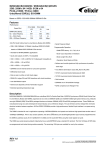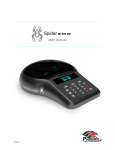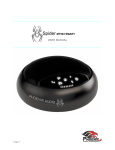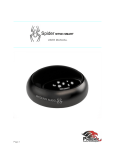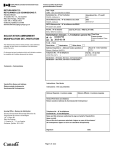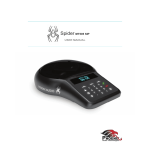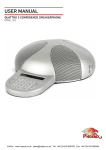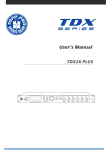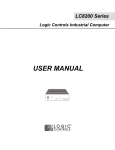Download phoenix audio mt 305 product manual
Transcript
User Manual Please read the instructions in these manual before using the Quattro Please refer to our website www.phnxaudio.com for more information, specifically to our Q&A section in our Support page . For additional help please send a detailed e-mail to [email protected] -1– Phoenix Audio Technologies www.phnxaudio.com Table of Contents 1. Introduction………………………………………………………………………….3 2. Key Elements………………………………………………………………………..4 3. Key Features………………………………………………………………………...6 4. Control and Panels…………………………………………………………………8 Primary (USB - Computer) Interface Panel Control Panel Secondary Panel 5. Using the Quattro with Your Computer - Connection and Operation…..12 6. PSTN Interface - Connection and Operation…………………………………14 7. VCA Interface - Connection and Operation…………………………………..17 8. Daisy Chain Interface - Connection and Operation…………………………20 -2– Phoenix Audio Technologies www.phnxaudio.com 1. Introduction The Quattro is a high quality speakerphone for use in medium to large conference rooms. It has an exceptionally large pickup and broadcasting range yet it is small in size. The Quattro utilizes multiple microphones, multiple speakers and a powerful DSP to obtain its performance. In its basic configuration the Quattro is designed for PC VoIP communication. In addition the Quattro may include an interface module that will communicate directly with your telephone line or other communication devices, per your choice. The Interface module can be replaced by the factory or by an approved dealer. Please send an e-mail to [email protected] or call your dealer for details. This manual covers instruction for the installation and usage of the Quattro in its basic configuration and with several selected interface modules. Specific instructions for other interface modules will be provided separately when you purchase a unit with that specific interface. Interface modules that are detailed in this manual include: - PSTN interface (POTS telephones) - VCA (video codec and analog) interface - Daisy Chain interface -3– Phoenix Audio Technologies www.phnxaudio.com 2. Key Elements The Quattro utilizes: - Four microphones - Four loudspeakers - A powerful Digital Signal Processor that performs the Quattro’s sophisticated audio processing. This processing includes: -4– o Detecting a person speaking o Finding the direction of the person speaking relative to the Quattro o Aiming a directional audio beam towards the person speaking (note: the Quattro can manage multiple people speaking simultaneously) o Eliminate the surrounding noise Phoenix Audio Technologies www.phnxaudio.com o Eliminate the Acoustic Echo o Eliminate the Line Echo (when used with PSTN interface) o Eliminate the room reverberation o Balance the input pickup level of the different speakers. o Balance the output signal level and adjusting it to the type of signal being broadcasted. The Result: Extended pickup and broadcasting range that can provide high quality communication in a large conference room setup. -5– Phoenix Audio Technologies www.phnxaudio.com 3. Key Features - Extended and powerful broadcasting capability: As a result of its unique design the Quattro drives up to 25 Watts peak power through its loudspeakers, delivering a strong and clear output signal. This feature is critical in large room coverage. - Ganging capability: The user can gang unlimited number of units for extended size room coverage. Each ganged unit will perform independent audio pickup processing and deliver it to the unit in front of it in the chaining hierarchy. The higher hierarchy unit will select the best available audio signal to pass on. Each of the ganged units will also transmit the output signal (more details in the Daisy Chain Interface chapter). - Battery operation: Each of the interface modules includes a built-in rechargeable battery. The unit does not have to be connected to the power supply for power. The user will be notified when the battery power is low. The unit can be recharged through the USB or with AC/DC wall mount power supply (supplied with the interface module). - -6– Three-Way communication: When using the Quattro with both the computer (through the USB interface) and an additional communication device (through the additional interface module - like the PSTN line) the Quattro mixes the incoming and outgoing signals so that the three partners (the Quattro user, the telephone communication and the computer communication) are full participants in the conference. Phoenix Audio Technologies www.phnxaudio.com In addition to being convenient in many instances, this feature allows to record the telephone conferencing and also playback audio files into the telephone lines. -7– Phoenix Audio Technologies www.phnxaudio.com 4. Control and Panels The Quattro has: A Primary (USB) interface panel A Simple control panel and A secondary interface panel (optional) Primary (USB - Computer) Interface Panel The Quattro has a primary (USB) panel that includes three jacks: - USB (on the right) for computer communication -8– Phoenix Audio Technologies www.phnxaudio.com - Cascading (DIN6 - in the middle) for chaining additional Quattro units. This connector can also be used to connect an external microphone. The chained Quattro unit must have a Daisy Chain interface. Please refer to the Daisy Chain Interface chapter for more details. - 3.5mm for external speakers or headphones (using this jack will disable the Quattro’s internal speakers). Control Panel The Quattro’s control panel has five buttons: - Power On/Off and Mute button (in the middle) – see details of operation below. - Volume Up and Volume Down (to the right) - Interface control buttons (noted as L1 and L2 – to the left). These two buttons serve different functions depending on the interface module you are using. In some cases (for -9– Phoenix Audio Technologies www.phnxaudio.com example in the computer only configuration) these buttons have no role and are not functional. Operating the L1 and L2 controls: please refer to the specific interface module you have on your unit. Light Indications Power/ Mute button light off - the unit is off Steady Power/ Mute light – unit is on Blinking Power/Mute light – the unit is on and the microphones are muted. L1 or L2 light is on – the button is active. For example – when using the PSTN interface L1 light on indicates that Line 1 in connected. Power On / Power Off / Mute operation: - To turn on: push the Power/Mute button. The light will turn on. - To turn off: push the Power/Mute button and hold for a few seconds. The units will beep four times and turn off in the fifth. The light will turn off. - 10 – Phoenix Audio Technologies www.phnxaudio.com - To mute: push the Power / Mute button (for less than 3 seconds). The light will start blinking. - To un-mute: push the Power / Mute button (for less than 3 seconds). The light will stop blinking and become steady. Notes: (1) The unit can be turned off from both On position or Mute. In both cases turning off requires pushing and holding the button for about 4 seconds. (2) After turning the unit off – you should wait a couple of seconds before turning it On again. Otherwise the unit may fail to turn On. Secondary Interface Panel If your Quattro is equipped with an additional interface module it may have a secondary panel – depending on your specific interface. Details and description are provided within the instructions of your specific interface module. - 11 – Phoenix Audio Technologies www.phnxaudio.com 5. Using the Quattro with Your Computer - Connection and Operation 1) Plug the USB cable (supplied) into the Quattro on one end, and to your computer on the other end. 2) Push the Power Button – the unit will turn on (blue light is on as an indication). The unit will identify itself as Phnx MT301. In most cases the Quattro will become your system’s default audio device. In some cases (depending on the application you are using and on the operating system you are running) you’ll have to select the Quattro as your Audio Input and Output device. Note: if your unit does not have a battery (if it’s not equipped with an interface module), or when the unit’s battery power level is low, the unit will turn on as soon as you plug it into the USB port and you will not have to push the Power button to turn On. You will still be able to turn the unit Off and On again as you wish. 3) You can control the unit’s pickup level (microphone) using your computer’s audio controls. You can control the unit’s playback (speaker) level using either the computer’s audio controls or the unit’s Volume Up / Volume Down controls. - 12 – Phoenix Audio Technologies www.phnxaudio.com Note: when working with both a VoIP application and an additional communication interface, it is recommended that you set the speakers level using your computer’s volume controls first. Then you can use the unit’s volume controls to set the output level of both interfaces to a comfortable level. The reason is that your computer controls only the level of signal coming out of your computer and not of the other interface while the unit’s volume controls affect both. 4) Push the power button with a short push to toggle between Microphone On and Mute. When muted – the light will blink. 5) Push and hold for 4 seconds to turn the unit off (the unit will beep four times and turn off on the fifth). - 13 – Phoenix Audio Technologies www.phnxaudio.com 6. PSTN Interface - Connection and Operation 1) The PSTN interface panel has two RJ jacks – one narrower than the other. A unique telephone cable is supplied with the unit. This cable has a narrow RJ connector on one end, and a wider one on the other. 2) The Quattro utilizes your telephone for the dialing and ringing functions. It is connected directly to your PSTN line (through the RJ jack in the wall) using a standard telephone cable (provided with your phone). The telephone is connected to the Quattro using the unique cable supplied with the Quattro. Note: the unit is supplied with a 6’ cable. A 20’ cable is also available and can be purchase separately. 3) If your telephone is currently connected to your telephone line – unplug the cable from your telephone (leave the “wall side” connected) and plug the loose end to the Quattro (the wider jack on the right). If your telephone is not connected to the telephone line, use a standard telephone cable, plug one end to the Quattro (wider jack on the right) and the other end to your telephone’s line wall jack. - 14 – Phoenix Audio Technologies www.phnxaudio.com 4) Plug the narrow connector of the unique cable to the Quattro (left side) and the other side to your telephone (same jack that you unplugged before and is typically used to connect your telephone to the line). 5) You can now use your telephone as before to dial out and get calls in. 6) L1’s (or L2) position determines whether your telephone is connected to the line or the Quattro (refer to the functional drawing on the next page). When L1 is active (light is on) the Quattro is connected, when it is inactive (light is off) your telephone is connected. 7) Please follow these steps to conduct a conference call: PSTN Connection Diagram a. Dial out: pick-up your telephone’s handset and dial the number you want to call. At any time after dialing push L1 (or L2 if you dialed using line 2) to transfer the call to your Quattro. The Quattro is now connected to the line and your - 15 – Phoenix Audio Technologies www.phnxaudio.com telephone is disconnected. As such the telephone is currently not functional and you cannot utilize its dial-pad, unless you switch the call back to your telephone (see C below). b. Accepting a call: when your telephone rings you can push L1 (or L2 if the call is coming from line 2) to accept the call on the Quattro. No need to pickup the handset. c. Switching back to your telephone: Pickup the telephone’s handset and push L1 (or L2 if the call is on line 2). The Quattro will be disconnected form the line and you can use your telephone ordinarily. L1 PSTN Functional Diagram - 16 – Telephone Line Phoenix Audio Technologies www.phnxaudio.com 7. VCA Interface - Connection and Operation The VCA interface is an Analog In / Analog out interface. It can be utilized to connect the Quattro to a Video Set-top Codec, a computer’s sound card or a digital phone headset jack. The black RCA jack on the right should be connected to your VC system’s (or sound card’s) output (the signal that goes to the loudspeakers. The red RCA jack on the left is the Quattro’s output and it should be connected to your VC system’s (or sound card’s) Input. The VCA interface has a sensitivity control switch which offers 8 different settings of output signal level. This allows the user to tune the Quattro’s output level and optimize it to the specific VC (or sound card) input level specifications. The output levels for the different switch settings are detailed in the following table (note: the orientation of the switches in the diagram represents the way these switches appear when the Quattro is sitting on the table): - 17 – Phoenix Audio Technologies www.phnxaudio.com Switch Position Output level peak-to-peak Switch Position Output level peak-to-peak Line level 3.0v Mic level 0.5v Line level 1.5v Mic level 0.25v Line level 0.75v Mic level 0.125v Line level 0.375v Mic level 0.0675v In order to use the VCA interface with a digital phone’s headset jack you need the proper cable (two RCA to RJ11). There are two types of wiring depending on the type of telephone you are using. These cables are available for purchase separately. Using external speakers If you wish to use your VC’s speakers you can either: 1) Connect the VC out to the right RCA jack, and connect your speakers to the 3.5mm “external speakers” jack on the Quattro’s primary panel. Or - 18 – Phoenix Audio Technologies www.phnxaudio.com 2) Using a RCA Y cable, split the VC out, connect one end to the Quattro (right RCA jack) and the other end to your speakers. This way requires less cables running back and forth from your VC to the Quattro. Note that in this configuration the Quattro’s internal speaker will work in addition to the external speakers. If you wish to disable the internal loudspeakers you can plug a Dummy 3.5mm plug into the 3.5mm jack (in the primary interface panel). Such dummy plug can be purchased separately (you can use any 3.5mm plug for this purpose). Video Codec Quattro Out Dummy Plug (Optional) VC Speakers Out Splitting Connection - 19 – Phoenix Audio Technologies www.phnxaudio.com 8. Daisy Chain Interface - Connection and Operation Several Quattro units can be chained to provide larger room coverage. One of the Quattro’s need to be connected to the communication line (or computer for that matter). Another Quattro will be connected to Quattro number one; a third Quattro can be connected to Quattro number two; and so on. There is practically no limit to the number of Quattro’s that can be chained. In this chain, we refer to the Quattro higher in hierarchy as a Master and the lower in hierarchy as a Slave unit. Any Quattro can be a Master, since the Master connection is provided with the basic unit and is included on all Quattro’s via the primary interface panel. In order for a Quattro to become a Slave unit it needs to have a Daisy Chain interface. Connecting a Slave unit to a Master is done using a unique cable supplied with the Daisy Chain interface. Unique Cable - 20 – Phoenix Audio Technologies PSTN or Other Network Connection www.phnxaudio.com Powering the Slave unit: the Slave unit has a battery and it does not need any extra power supply. If the battery on the Slave unit runs low, the unit will turn Off its loudspeakers. The unit’s microphone and audio processing will still run, powered by the Master through the connecting cable. Remember: if the Slave unit’s battery is low it is still powered and operational; it will just shut off its loudspeakers to preserve power. The Master unit can supply enough power to operate the Slave unit’s microphones and processor but not its loudspeakers. You can connect the Slave unit to an external power supply using an AC/DC converter which is supplied with the Daisy Chain unit. Microphone Pickup Performance: the Slave unit is not just a simple satellite microphone. The unit runs the same audio processes as a stand alone unit, including the person speaking detection, direction finding, and tracking. The Slave unit will transfer its processed audio to the Master unit which will weigh its quality against its own pickup quality. If the talker was closer to the Slave and was picked up better by the Slave the Master will select the Slave’s signal as the preferred one. With two units connected you have in actuality eight microphones searching and tracking the best possible audio signal. The diagram below illustrates the process: - 21 – Phoenix Audio Technologies www.phnxaudio.com PSTN Line Thank you for purchasing the Quattro. For more information please refer to our Website www.phnxaudio.com or call (516) 829-2920 - 22 – Phoenix Audio Technologies www.phnxaudio.com






















